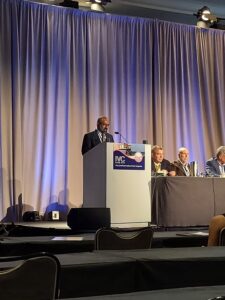
The importance of activating the calf muscle pump in the treatment of lower extremity lymphedema came to the fore during the 2024 International Vein Congress (IVC) in Miami, Florida (April 18–20).
“There are a whole host of non-proffered approaches you can take,” said Brajesh Lal, MD (Baltimore, Maryland), giving a presentation focused on what he believes is the best time to use lymphedema pumps and nonsurgical interventions for treating lymphedema. “Most important and primary are elevation of the limb, exercise if you’re dealing with low extremity edema, which is what most of us will be dealing with, and activating the calf muscle pump.”
Where do pumps fit into a treatment paradigm that includes massage, exercise, and compression garments, Lal pondered.
There are numerous options for pumps on the market, including nonsequential pumps and pumps that provide both sequential and segmental compression, he said. These restrict patients to their beds during the 30 to 60 minutes of daily treatment. One of the more recent to be introduced are non-pneumatic pumps. These are less bulky and permit patients to continue ambulating.
One of the biggest issues with pumps currently is that there are numerous guidelines that all claim to promote best practice, Lal continued. Though they promote best practice, they are “limited by a lack of standard descriptions, a standard way of providing their recommendations, and, of course, a limited quality of the evidence available,” he stated.
“I want to be very careful separating out where there is evidence and where there isn’t, and where there is opinion,” Lal told the audience. “All guidelines recommend initial decongestive therapy followed by maintenance decongestive therapy. Though the recommendation was strong, evidence for this approach has not been tested in any highly-quantitative manner..”
All guidelines also recommend elevation, exercise, and compression garments, though they vary in how they express their recommendations, Lal explained, saying he would be referencing the guidelines created by the American Venous Forum (AVF), “which is essentially a strong recommendation based on either moderate, moderate-good, and very good quality data.
“Manual lymphatic draining or massage has been given various grades even when the level of evidence is modest,” Lal said. “Pump-assisted compression, however, generally gets a low-moderate grade recommendation in view of the evidence available.” There is another new form of lymphedema treatment arriving soon in the form of non-pneumatic compression devices, he added.
Ultimately, Lal said he uses pumps, “as an adjunct to elevation, exercise and compression. I use it in patients who have severe edema and very large limb volumes, those who have limited ambulation, and those who cannot apply compression devices when they go into the maintenance phase.”











